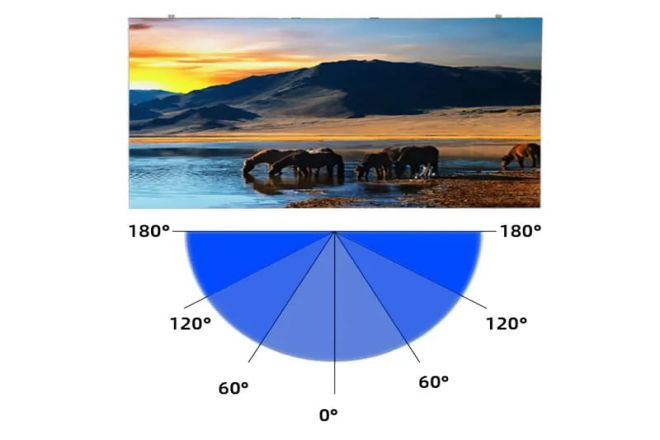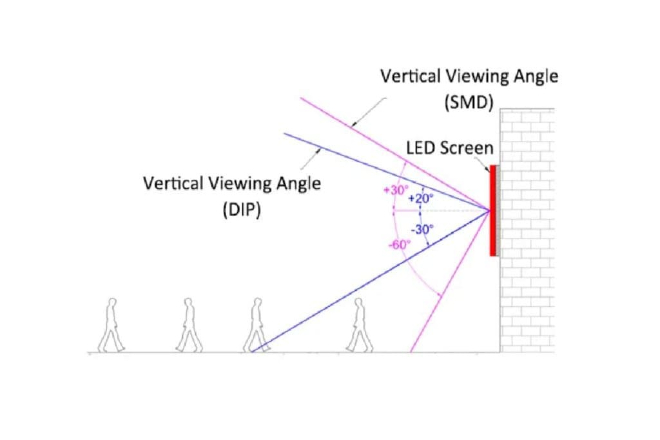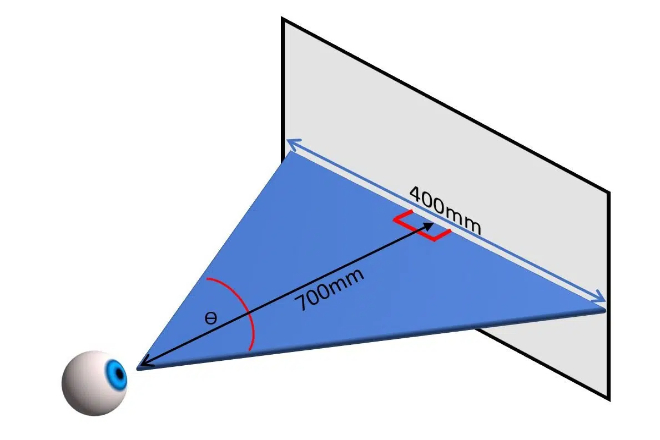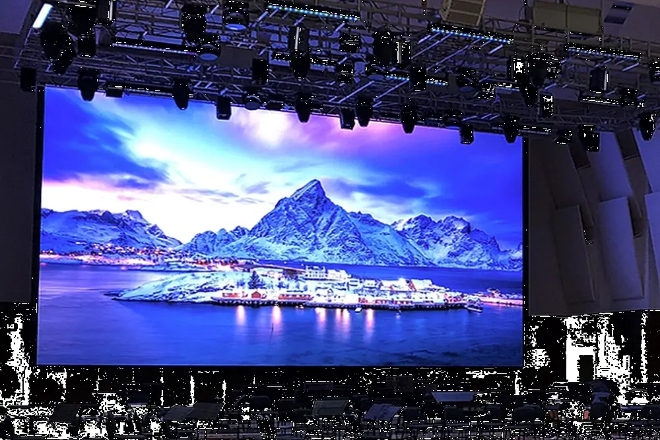介绍

In order for an LED广告屏 to fully exert its advertising effect and attract the audience’s attention, in addition to the design of the content itself, the viewing angle selection during installation is also crucial.
A poor 可视角度 may cause picture distortion and color distortion and even make it impossible for the audience to clearly see the advertising content, thereby greatly reducing the communication effect of the advertisement.
So, how to find and determine the best viewing angle to ensure that the advertising content can be presented to the audience in the best state and enhance the communication effect and commercial value of the advertisement?
目录
1. What is the best viewing angle for an LED advertising screen?
1). 可视角度:
The viewing angle is actually the angle range at which the screen can remain bright when we look at the LED advertising screen.
Imagine that you are looking at the screen, then slowly turn to the left or right, or look up and down, until the screen becomes too dark to see clearly. The angle of rotation is the viewing angle.
1.1). Horizontal viewing angle and vertical viewing angle:
The horizontal viewing angle is the angle at which you can still see the screen bright when you turn your head left or right; the vertical viewing angle is the angle at which you can still see the screen bright when you look up or down.
When measuring, just take an instrument, point it at the screen, and then slowly turn it to see when the screen becomes too dark. That angle is the viewing angle.
1.2). Viewing angle:
The viewing angle is the angle at which you can barely see what is on the screen. At this angle, although the screen may not be so bright, you can still see it roughly.
1.3). Optimal viewing angle:
The optimal viewing angle is the angle at which you can see the screen most clearly, and the color is most accurate. At this angle, the screen looks like it is right in front of you, very real.
2). Measuring method of horizontal viewing angle and vertical viewing angle
In fact, it is quite simple to measure horizontal viewing angles and vertical viewing angles.
Just take a brightness meter or something, point it at the screen, and slowly turn it. In the beginning, the screen must be very bright, and then you turn it around, and the screen slowly becomes darker.
When you turn to a certain angle, the screen brightness becomes half of the original, or the contrast drops to a certain level (such as 10:1), and that angle is the viewing angle.
The horizontal viewing angle is measured when turning left and right, and the vertical viewing angle is measured when turning up and down.
3). Interpretation of viewing angle parameters
3.1). The meaning of viewing angle parameters (such as 160°/140°) provided by LED display manufacturers:
For example, the manufacturer says that their screen viewing angle is 160°/140°, which means that as long as you turn your head left or right and it does not exceed 80° (because 160° is 80° on one side plus 80° on the other side), the screen is still quite bright.
You look up or down, as long as it does not exceed 70° (because 140° is 70° on one side plus 70° on the other side), the screen can still be seen clearly.
3.2). The impact of viewing angle on the audience’s viewing effect:
- The larger the viewing angle, the wider the viewing range:
The advantage of a larger viewing angle is that more people can see the screen at the same time. For example, if you stand across the street, you can also see clearly what is on the advertising screen across the street, so the advertising effect will be better.
- The trade-off between viewing angle and 亮度:
However, there is also a problem with a larger viewing angle, that is, the screen may become less bright. Because the light has to be scattered over a larger range, there is less light in each place.
So when choosing a screen, you have to see if the brightness is enough. Don’t choose a screen that is too dark to see clearly just for a wide viewing angle.
- Difference in viewing effect:
When you look at the screen at the best viewing angle, the feeling is different. The colours are particularly bright, and the images are particularly clear, just like looking at the real thing.
But if you exceed the best viewing angle, the screen may become a little blurry, and the colours may not be accurate. So, when looking at the screen, you still have to find a good angle.
In general, when choosing an LED advertising screen, you have to consider factors such as viewing angle, brightness, and resolution.
A wide viewing angle is good, but the brightness must be enough; a high resolution is clear, but the price may also be high. So you still have to choose according to your needs and budget.
2. What are the factors that affect the viewing angle of LED advertising screens?

1). LED chip packaging method
1.1). The impact of different packaging methods on viewing angle:
SMD packaging is like sticking a bunch of small LED lamp beads tightly on a board. The resulting display has a high pixel density and looks particularly clear.
Moreover, its viewing angle is quite wide, about 140°, and you can see the content on the screen clearly even if you stand next to it.
DIP packaging is to directly insert the LED lamp beads into the board. The viewing angle of the display screen made in this way is relatively narrow, about only 100-110°.
Moreover, it is more troublesome to produce and the efficiency is not high.
COB packaging is even more powerful. It directly encapsulates the LED chip on the board without the protruding part of the lamp bead, so the viewing angle is particularly wide, reaching 160° or even more.
Moreover, its brightness is also very high, especially suitable for outdoor use.
1.2). Advantages and disadvantages and applicable scenarios:
- SMD packaging:
The advantage is wide viewing angle and high clarity, which is suitable for occasions that require a high-definition display, such as high-end commercial advertisements, indoor exhibitions, etc. The disadvantage is that the cost may be a bit high.
- DIP packaging:
The advantage is a mature technology and low cost, which is suitable for occasions that do not require high viewing angles but care more about cost, such as some simple signs and logos.
- COB packaging:
The advantages are ultra-wide viewing angle and ultra-high brightness, which is especially suitable for outdoor advertising screens and stage background screens that require wide viewing angles and high brightness.
The disadvantages are that the cost and technical difficulty are relatively high.
2). Display module and manufacturing process
High-quality display modules and fine manufacturing processes are like putting on a custom-made piece of clothing for the LED advertising screen, making it look perfect.
A good display module means more uniform pixels and better display effects. Fine manufacturing processes can reduce light scattering and reflection, making the viewing angle larger.
3). Pixel density and lamp bead arrangement
3.1). The effect of pixel density on viewing angle:
Pixel density is like the small dots on the screen. The more dots there are, the clearer the picture.
However, too many dots are not good either, because the distance between the dots becomes smaller, and light is easily scattered and reflected between the dots, affecting the viewing angle. Therefore, the pixel density should be moderate.
3.2). The effect of lamp bead arrangement on viewing angle and display effect:
The arrangement of lamp beads is also very important. If the arrangement is reasonable, the scattering and reflection of light can be reduced, making the contrast and clarity of the display screen higher.
Moreover, different arrangements will affect the viewing angle. Therefore, manufacturers must carefully consider these factors when designing.
4). Ambient lighting conditions
The light intensity of the outdoor environment is a big problem. If the light is too strong, the display screen will appear very dark and unclear. Moreover, strong light will reduce the contrast of the display screen and make the picture blurry.
In addition, the light intensity will also affect the viewing angle. Therefore, when using LED advertising screens outdoors, we must consider the factor of light intensity.
In order to improve the viewing angle and brightness performance of outdoor LED advertising screens, we can take some sun protection measures. For example, install a sunshade on the surface of the display screen or apply a layer of anti-reflective coating or something.
In this way, the impact of light on the display screen can be reduced. In addition, the brightness setting of the display screen can be automatically adjusted according to the ambient light intensity.
For example, adjust the brightness a little higher in strong light and adjust the brightness a little lower in weak light, which can save energy and ensure the viewing effect.
3. What is the impact of the installation position and viewing distance of the LED advertising screen on the viewing angle?

1). Installation position selection
1.1). The impact of different installation positions on the viewing angle:
- 墙壁安装:
Installing the LED advertising screen on the wall can provide the audience with a more direct and clear viewing experience. Wall installation is usually suitable for places with limited indoor or outdoor space, such as commercial blocks, 购物广场, ETC。
In this installation method, the viewing angle mainly depends on the size of the display and the distance between the audience and the screen.
If the installation position is high, the audience needs to look up to watch, which may affect the viewing comfort; if the installation position is too low, it may limit the audience’s viewing range.
- Column installation:
Column installation is usually used in places with large outdoor spaces, such as squares, stations, etc. In this installation method, the LED advertising screen can be placed independently, with a better field of view and independence.
Column installation can flexibly adjust the height and angle of the display to meet the viewing needs of different audiences. However, the cost of column installation is relatively high, and the stability and safety of the column need to be considered.
- Roof installation:
Roof installation is usually used in places that need to attract long-distance attention, such as the exterior walls of high-rise buildings, bridges or advertising towers.
In this installation method, LED advertising screens can expand the field of view and attract audiences from farther away.
However, rooftop installation needs to consider factors such as the load-bearing capacity, windproof performance and installation difficulty of the roof.
1.2). How to choose a suitable installation location according to the installation environment:
When choosing an installation location, it is necessary to comprehensively consider factors such as the number of viewers, viewing distance, viewing angle, environmental factors (such as light, temperature, humidity, etc.) and cost budget.
For example, in commercial blocks or shopping malls, wall installation may be a more appropriate choice.
In places with large outdoor spaces, such as squares or stations, column installation may be more appropriate; and in places that need to attract long-distance attention, such as the exterior walls of high-rise buildings, rooftop installation may be more appropriate.
2). Viewing distance calculation and adjustment
2.1). Method for calculating the best viewing distance by dot pitch:
The dot pitch of the LED display (that is, the distance between two adjacent pixels) is one of the key factors in determining the best viewing distance.
Generally speaking, the best viewing distance can be estimated by multiplying the dot pitch by a coefficient (usually between 1000 and 3000).
For example, for an LED display with a dot pitch of 2 mm (P2), the optimal viewing distance is roughly between 2 meters and 6 meters.
2.2). The importance of adjusting screen specifications and installation angles according to the audience’s viewing distance:
In the actual installation process, it is necessary to select appropriate screen specifications and installation angles according to the audience’s viewing distance.
If the audience is far away from the screen, it is necessary to select a screen with a larger dot pitch and a larger size to ensure that the audience can clearly see the screen content.
At the same time, it is also necessary to adjust the installation angle of the screen to meet the audience’s viewing needs.
For example, in outdoor advertising, if the audience is mainly distributed on both sides of the road, the installation angle of the screen needs to be adjusted to tilt to both sides so that the audience can better view the screen content.
In addition, the impact of environmental factors on the viewing distance also needs to be considered.
For example, in a strong light environment, in order to maintain the viewing effect, it may be necessary to appropriately shorten the viewing distance or increase the brightness of the screen.
In a weak light environment, the viewing distance can be appropriately extended or the brightness of the screen can be reduced to save energy.
In summary, the installation position and viewing distance of the LED advertising screen have a direct impact on the viewing angle.
When choosing an installation location and calculating viewing distance, multiple factors need to be considered to ensure that viewers can get the best viewing experience.
4. How to find the best viewing angle for LED advertising screens?
1). Preliminary measurement and planning
Before installing the LED advertising screen, we must first do a “full body check” of the installation environment, that is, preliminary measurement and planning. This step is very important, as it determines where, how, and how high the screen is installed.
- Measuring the environment:
You need to use a ruler to measure how big the installation area is and what shape it is, and then see if there are any obstacles around, such as big trees, tall buildings, etc., which may affect everyone’s viewing of the screen.
- Planning the location:
After measuring, you have to think about where the screen is most suitable to be installed. Generally speaking, you have to choose a place with a large flow of people and where everyone’s eyes are easily focused.
- Determine the angle and height:
You also have to think about how much the screen should be tilted and how high it should be installed. This depends on everyone’s usual viewing habits, and you have to ensure that everyone can see the content on the screen clearly.
2). Adjust the screen angle and height
After the screen is installed, don’t think that it’s done. You still have to adjust the angle and height of the screen according to the actual viewing position and distance.
- Observe the viewing angle:
Don’t rush to install it. Look at the screen from different positions to see if everyone has to look up or down when watching. If so, you need to adjust it.
- Adjust the angle:
According to the results, tilt the screen so that everyone’s eyes are almost level with the screen or slightly lower so that it is most comfortable to watch.
- Adjust the height:
Also, check whether the screen is installed high. If it is too high, everyone has to look up to see it, and if it is too low, it may be blocked. You have to adjust the height to a suitable level so that everyone can watch comfortably.
3). On-site testing and adjustment
Don’t rush to celebrate after the adjustment. You have to do an on-site test to see the actual effect.
- Invite audience testing:
Find some people, let them look at the screen from different positions, and then ask them how they feel. In this way, you can know where the screen looks good and where you need to change it.
- Observe the viewing effect:
You also have to take a close look to see if the content on the screen is clear, whether the color is good, and what the contrast is. If you feel uncomfortable watching any part, it may be that the angle or height of the screen is not adjusted properly.
- Fine-tune the angle and height:
According to the test results, slightly adjust the angle and height of the screen. This may take several attempts until you find the angle and height that everyone is most comfortable watching.
Speaking of which, it is not an easy task to find the best viewing angle of the LED advertising screen. You have to measure and plan, and you have to adjust it after installation, and finally test it on site.
However, as long as we are patient and take it step by step, we will definitely find the angle and height that makes everyone watch the most comfortably. In this way, our advertising screen can play the greatest effect!
5. Strategies for finding the best viewing angle in different scenarios

1). Indoor scenes
Indoors, everyone’s habits and standing positions when watching LED advertising screens are quite interesting. For example, in shopping malls, everyone may like to join in the fun by the escalator, in the atrium or at the door of the store.
In the meeting room, everyone sits in their seats in an orderly manner. These locations are places with large traffic or particularly good sight lines.
- Preliminary planning:
We need to look at the indoor layout first, think about how the audience will move, and then determine the approximate installation position and angle. We need to ensure that the screen can cover most people and is not blocked by anything.
- On-site measurement:
Before installation, you need to measure with a ruler to see how high the screen should be installed and how much it should be tilted. You can also find a few people to simulate and listen to what they say.
- Fine-tune the angle:
Don’t rush to leave after installation. You need to take another look. According to the on-site situation and feedback, slightly adjust the angle of the screen to make it more comfortable for everyone to watch.
- Light adaptation:
The indoor light is different, and the screen must be adjusted accordingly. If it is too bright, it must be dimmed, and if it is too dark, it must be brightened to ensure that everyone can see clearly.
2). Outdoor scene
The outdoor environment is much more complicated, and sunlight, wind, temperature, and humidity must all be considered. If the sunlight is too strong, the screen may reflect light.
If the wind is too strong, the screen may shake; if the temperature and humidity change, the screen may have problems.
- Site selection considerations:
The place where the screen is installed must be selected, not exposed to direct sunlight and not too windy. For example, the side of a building or under a sunshade is good.
- 防水设计:
Outdoors, it rains a lot, so the screen must be waterproof. Make sure that rain can’t get in so that the screen can be used for a long time.
- Windproof reinforcement:
The screen must be stable when the wind is strong, so it must be reinforced. Use sturdy brackets and cables to prevent the screen from being blown down by the wind.
- Earthquake-proof measures:
In places where earthquakes are frequent, earthquake-proof measures must also be considered. Use earthquake-proof technology to install the screen to ensure that the screen is stable during an earthquake.
- 角度调整:
The outdoor environment is changeable, and the angle and height of the screen must also be adjusted accordingly. Make sure that everyone can see clearly in different light and weather.
3). Special scenes (such as transportation hubs, commercial districts, etc.)
In places like transportation hubs and commercial districts, people come and go, and their viewing habits are also different.
Some people pass by in a hurry, and some people stop to look. How to attract everyone’s attention and let the content be conveyed quickly, you have to think carefully.
- Prominent location:
The place where the screen is installed must be conspicuous, and it can be a place with many people and a good line of sight. For example, the entrance of a station or the central square of a commercial district.
- Dynamic content:
The content must be dynamic and attractive. Animation, video, etc., are all fine so that everyone will be attracted at first sight.
- 亮度 调整:
The outdoor light changes greatly, and the screen brightness must also be adjusted accordingly. If the sunlight is strong, the bright spot must be adjusted to ensure that everyone can see clearly.
- Multi-angle installation:
If conditions permit, the screen can be installed at multiple angles. This will cover more viewers, and everyone can see from different directions.
- Interactive elements:
It is also fun to add some interactive elements. Touch screens, code scanning interactions, etc., are all fine so that everyone can participate and make it more interesting.
In general, the best viewing angle search strategy in different scenarios must take into account many factors. Audience habits, environmental factors, and content communication effects must all be considered.
Only through reasonable planning, measurement, adjustment and design can the LED advertising screen play the best publicity effect in different scenarios. We have to do it with our heart to make the audience like our screen!
6. Future trends and prospects of LED advertising screen viewing angle
1). Technology development trend
1.1). Future trend of improved viewing angle:
Did you know? The future LED display screen will have a big move in viewing angle! Although the current LED screen has a good viewing angle, future technology will make the viewing angle wider and more uniform.
No matter where you stand, you can clearly see the content on the screen, just like being there.
1.2). The impact of new technologies on viewing angle:
Speaking of new technologies, micro LED and Mini LED are the hottest newcomers! Micro LED has extremely small pixels, high resolution, and super contrast.
Most importantly, its viewing angle can reach almost 180 degrees, so you can see it clearly wherever you stand.
As for Mini LED, it has more backlight partitions, and the brightness and contrast are even better. Its viewing angle is not bad, and it can meet most scenarios.
2). 市场需求变化
2.1). New requirements of the advertising market:
The current advertising market is changing very fast! Customers have higher and higher requirements for the viewing angle of LED advertising screens. They hope that the screen can cover more people and increase the advertising exposure rate.
At the same time, they also hope that the screen display effect can be more realistic and more attractive. After all, today’s audiences are very picky, and they will not take a second look at ugly advertisements.
2.2). Adapt to market demand and improve competitiveness:
In order to keep up with the pace of the market, LED advertising screen manufacturers have to work harder! They have to continuously develop new technologies to improve the viewing angle performance and display effect of products.
They also have to customize exclusive advertising screens according to customer needs. In this way, they can meet the discerning eyes of customers and improve the competitiveness of products.
In fact, manufacturers can do more market research to understand what customers really want. Then, according to these needs, they can develop new technologies and new products. In this way, customers can be satisfied and products can be sold well.
七、结论
From the above article, it is not difficult to see that the best viewing angle is actually very important for LED advertising screens. It has a certain impact on improving advertising effects and attracting audience attention.
Looking to the future, with the continuous development of LED display technology and changes in market demand, we believe that there will be more innovations and breakthroughs in improving viewing angles, providing stronger support for the widespread application of LED advertising screens.
最后,如果您想了解更多关于LED显示屏的知识, 请与我们联系。
